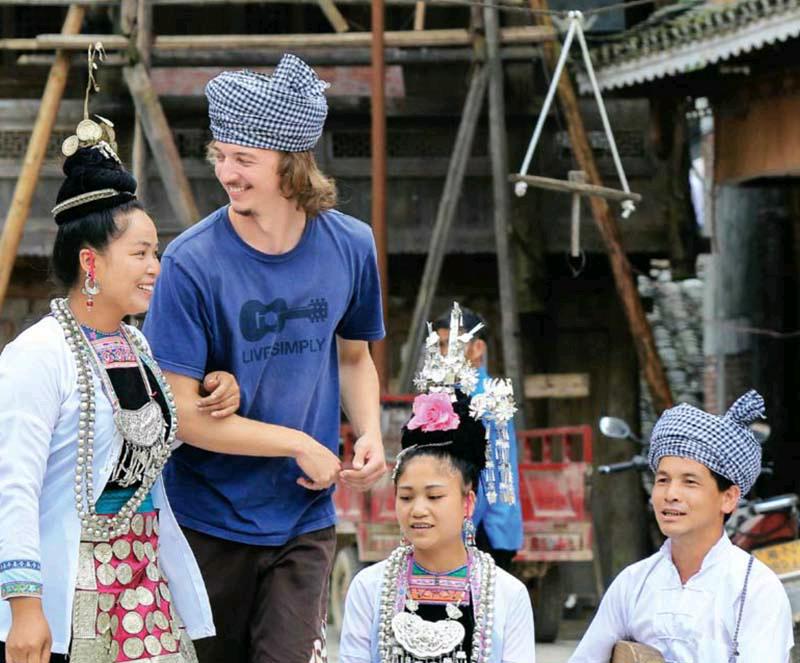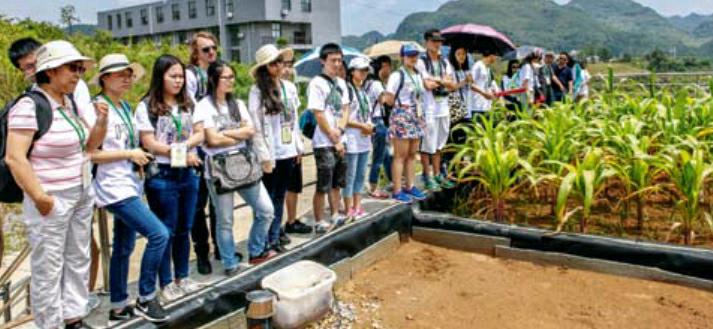Minorities & Modernity
2015-12-11byWangDongping
by+Wang+Dongping
Green Alliance of Universi- ties for a Sustainable Future(GAUSF), a research and teaching alliance, is breaching boundaries in its bid to establish an international platform for eco-civilization construction and education. A GAUSF group of more than 50, who landed in Guizhou University has, after an orientation program, set out on a field trip across villages and small cities in southeastern Guizhou.
Initiated in 2014, GAUSF includes 12 universities from China, America, Israel, Germany, Japan, Britain and Australia. The exploration started with a series of intensive lectures in Guizhou University. The participants are lecturers, students, researchers and activists from different countries with diverse backgrounds. Some of them majored in areas of science and technology such as environmental and materials engineering, agronomy, and forestry, while others are from social science streams such as philosophy, political science, and history. Some of them are graduates undecided on their next step, while others are PhD scholars working in specialized areas. What they all share is curiosity about minority culture, village life and local wisdom on eco-sustainability in Guizhou Province.
The groups multi-disciplinary background and global outlook was evident during the Q&A session, students discussion, and interpretations and understanding of the summer in southeastern Guizhou.
The Karst Experience
Their exploration started with a visit to Karst Ecological System Observation and Research Station of the Chinese Academy of Sciences in Puding County. Here, Prof. Zhang made a presentation that focused on two working programs: one on how to improve plant coverage in the typical stony and arid regions of Puding; the other on how to collect and save water for irrigation in highland farming.
The projects on Karst are designed to take advantage of the mountainous landscape where local resources have played an important role in combining environmental protection and economic development. In Puding, the research station joined hands with the local government to provide funding for farmers and for further research.
The students, who walked to a village near Yelang along with the administrative officer, were interested in the local experience in growing “Suosai Peach.” This is a popular peach variety that has helped improve the living standards in the area.

The students had animated discussions on the nature and impact of modernization.“During the field visit, we have found that the local people actually long for a modern life. With modernization, everybody enjoys better income and living standards. But shouldnt there be some reflection on the process and changes it might bring about?”a student from Berlin-based Free University asked.
Taste of Minority Culture
After the visit to the village and research station, the GAUSF group moved to Congjiang, a minority county in southeastern Guizhou. The ‘minority culturetrip began with a cultural performance in Xiaohuang Dong Minority Village, after which they proceeded to Huanggang Dong Village for observing the everyday life of the inhabitants. Following the trip in Huanggang, they drove to Basha Miao Village. Thereafter, the group was exposed to another minority group, known as Miao, by being taken to a typical Miao village. This village, funded by the local government, also receives international assistance including from the World Bank. The daily life, including funeral and festival rites, of the Miao ethnic group is documented and exhibited for the benefit of tourists.
The exposure to minorities was followed by a visit to Jiabang Terrace. Here, Prof. Li from Peking University gave a lecture on a mistake made by villagers in the 1980s. They had cut all the trees that were planted near the terrace in pursuit of a decision to plant another type of sticky rice for improving productivity. But, it didnt work. On the contrary, production fell steeply and the failed experiment cost local people all the terrace trees.
The field trip concluded in Zhenyuan Ancient County, where the students were impressed by the structure of the ancient city and a lecture on traditional Guizhou food.
The experience in southeastern Guizhou was an eye-opener for the group on the transformation in Chinas countryside especially in the minority region. This emerged in the concluding session where reports were presented and discussed. Some of the points made in this session merit closer attention and reflection.
One of the students pointed out that much attention was given to villages, while cities are ignored. But villages are not closed communities; they are closely connected to cities. For example, in Huanggang Dong Village, many young villagers are working in the cities, and most return only once a year. Villages operate along with cities and interact closely with cities even when the villages are geographically far away.